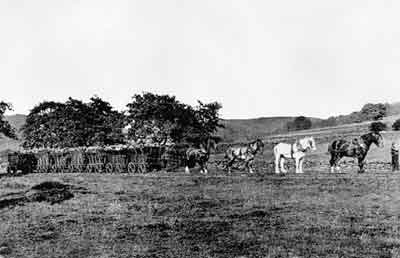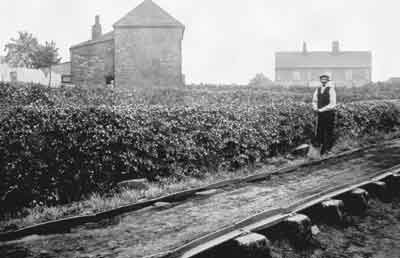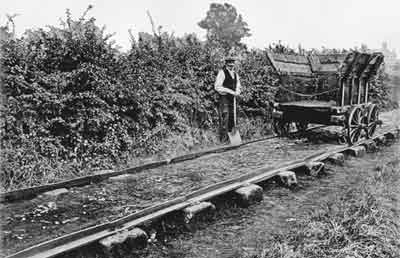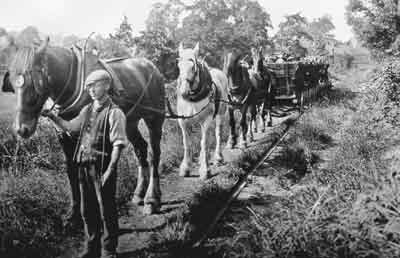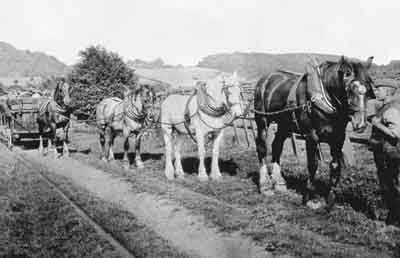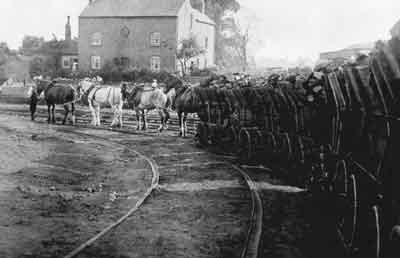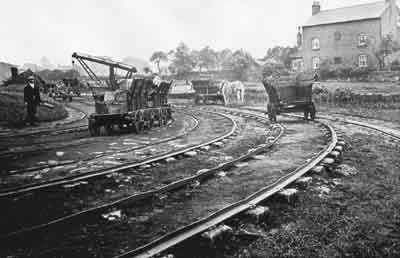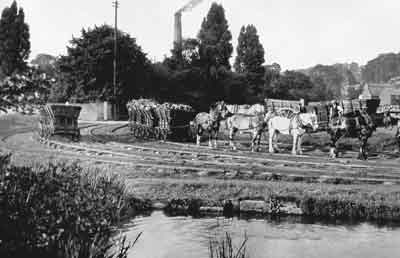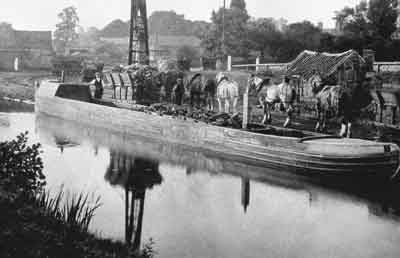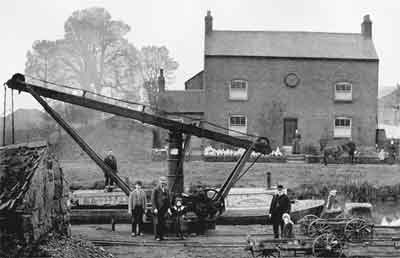The Little Eaton Gangway closed in Jul 1908 and the 11 photos in the above slideshow are of the last gang of waggons to travel down the full length of the gangway, from Denby to Little Eaton, on the day of its closure. To view the slideshow click on the photo and move forward by clicking the right side of each photo.
This gangway is also known as the Derby Canal Railway and the Little Eaton Tramway. The township of Little Eaton is situated 3¼ miles north-north-east of Derby and 4 miles south of Belper, on the banks of the river Derwent where it marks the western boundary of Erewash.
Following authorisation by Parliament, work began on the construction of the Derby Canal with Benjamin Outram as the Consulting Engineer. The canal was just over 14-miles long and it ran from Sandiacre on the Erewash Canal, through Borrowash, Spondon and Derby to Swarkestone on the Trent and Mersey Canal. At Derby there was a 3⅛-mile long branch (Little Eaton Branch Canal) heading northwards to the village of Little Eaton and a short branch in Derby that connected with the river Derwent. At Little Eaton there was an interchange with a gangway, first proposed by William Jessop on the 3 Nov 1792, which became known as the Little Eaton Gangway. The purpose of this gangway, which was some five-miles long, was to act as a feeder to the Derby Canal by principally carrying coal from Kilburn (Kilbourne) Colliery (1854-1905/06) and Denby/Denby Hall/Denby Drury Lowe Colliery (1875-1967) in the Amber Valley down to the canal at Little Eaton via Coxbench. The two collieies were about 1.48 miles distant from each other. The whole course of the Derby Canal and the Little Eaton Gangway was in the County of Derbyshire.
Work on the construction of the gangway commenced in 1793 and the first batch of cast-iron rails was ordered from Joseph Butler, an ironmaster of Wingerworth near Chesterfield. These rails were 3-feet long and they weighed 28lb. Under the direction of Benjamin Outram, the gangway was completed in May 1795 and it had a single track, of 3 feet 6 inches gauge, with passing places. Some years later, Robert Stevenson reported that,
Mr Benjamin Outram, an engineer of acknowledged ingenuity and merit constructed the railway at Little Eaton in Derbyshire where the plate-rail was adopted, with the flanges cast upon the rails, for the direction of the waggons, instead of having them upon the wheels as is the case in the edge-railway.
This observation by the eminent engineer, Robert Stevenson, confirms that the Little Eaton Gangway was laid with L-section, cast-iron rails.
In connection with this, the Lincoln & Stamford Mercury for 16 Aug 1793 carried an advertisement for oak sleepers 4 feet 6 inches long squared at each end for a length of 9 inches. This advertisement suggests that stone sleeper blocks were not used at the time of the gangway's construction. At this distance in time from these events and with no material evidence, the dimensions of these sleepers do not fit easily with a gauge of 3 feet 6 inches, as the distance between the squarings was 3 feet and not 3 feet 6 inches. However, it does suggest that the sleepers were laid across the track in the manner of modern sleepers. Subsequently, the track was re-laid in accordance with Outram's specifications using stone sleeper blocks and L-section cast-iron rails to a gauge of 4 feet 2 inches and there is photographic evidence of this.
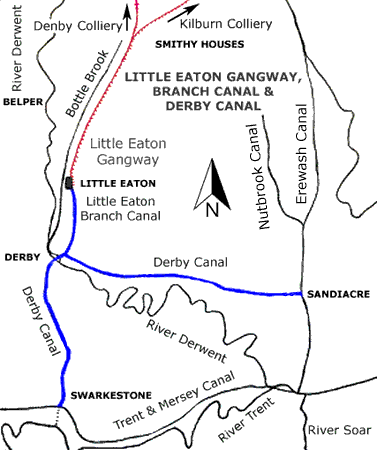
| Main Line | |
|---|---|
| No. | Name |
| 1 & 2 | Sandiacre |
| 3 & 4 | Borrowash |
| 5 | White Bear |
| 6 | Pegg's Flood Lock |
| 7 | Day's |
| 8 & 9 | Shelton |
| Connection to river Derwent at Derby | |
| 1 | Phoenix |
| Little Eaton Branch | |
| 1 | Pasture |
| 2 | Depot |
| 3 | Sharon |
| 4 | Eaton Top |
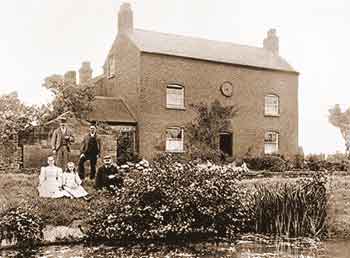
Clock House
This house was built in c.1795 by the Derby Canal Company for their agent and it was located on Little Eaton Wharf at the junction of the Little Eaton Branch of the Derby Canal and the Little Eaton Gangway (52.96563, -1.46329). Here there was an interchange where coal transported on the gangway was transhipped to boats on the canal.
The house is of red-brick construction with a tile roof. The front elevation, that originally faced the wharf, is two bays wide with windows flanking the central doorway. There are two similar windows above on either side of the clock.
Clock House is listed Grade II, List Entry No. 1329210.
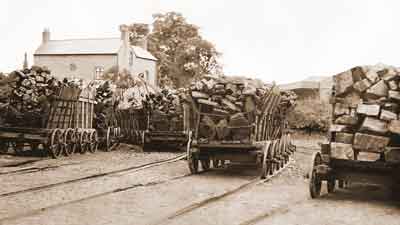
Waggons on Little Eaton Wharf waiting to be unloaded.
View looking south east at waggons loaded with coal from Denby Hall/Denby Colliery. Clock House stands in the background on the left.

Little Eaton Wharf.
View of the north east side of the wharf showing two boats being loaded with coal by two cantilever jib cranes.
To do this a four-leg lifting chain was used, each leg being hooked onto eyes at the top corners of the waggon body. The waggon body, complete with coal, was then lifted from its underframe and lowered into the boat which could hold four waggon bodies.
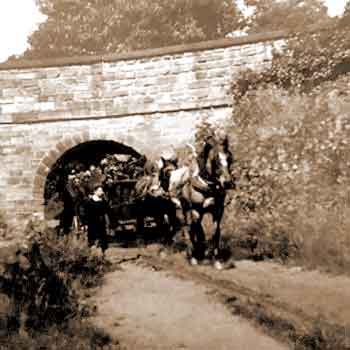
Jack O'Darley's Bridge.
This view shows a gang of loaded waggons on the Little Eaton Gangway passing below the bridge on its way to the terminus of the Little Eaton Branch of the Derby Canal.
This bridge is a significant surviving feature of the gangway situated on Alfreton Rd on the north side of Little Eaton (52.97398, -1.45910). It formed part of the Alfreton and Derby turnpike road that opened in 1807 and it carried the turnpike over Bottle Brook and the gangway. The bridge is aligned east-west and the eastern archway spanned the gangway. The bridge is stone built with semi-circular arches and coursed masonry parapets with flat ashlar coping stones.
It seems that by 1821 the bridge needed repairing and it was described as being 'insufficient for the traffic it carries'. Consequently, it was either extensively repaired or rebuilt by the Derby Canal Company who had obtained ownership of the bridge. However, in its final form the bridge had three arches that spanned the single-track Midland Railway Ripley Branch Line, Bottle Brook and the gangway.
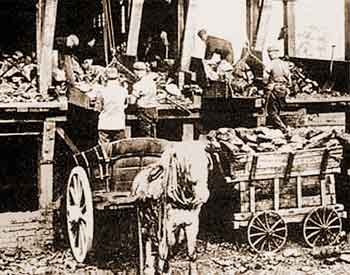
Loading coal at Denby Colliery
The waggon on the right is from the Little Eaton Gangway and the two-wheeled cart on the left is for delivering coal locally by road.
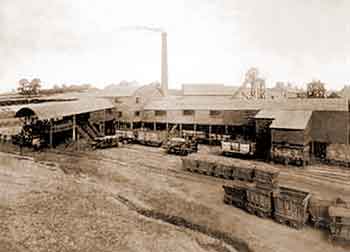
Denby Colliery.
The waggons in the foregound on the right are from the Little Eaton Gangway.
Abandonment of the Little Eaton Branch of the Derby Canal
Following the last delivery of coal from Denby Colliery along the Little Eaton Gangway and Little Eaton Branch Canal in Jul 1908, the gangway immediately became redundant and
there was little alternative trade on the branch canal. As a result, maintenance of the latter was uneconomic and the Derby Canal Company announced that it was their intension to abandon it.
However, it was not until 1935 that a formal application was made to abandon it. Their application was reported in the London Gazette on the 12 July 1935.
Subsequently, the Little Eaton Branch Canal was filled in and it is now the site of Sir Frank Whittle Rd (A61) and Alfreton Rd.
Pre-locomotive tramways
The development of iron railways (or tramways as they soon became known) in the pre-locomotive era is interesting and it is a story in which Benjamin Outram and his business partner, William Jessop,
took leading roles. Outram, more than anyone else, was responsible for the promotion of iron railways, which at the time were also referred to as plate railways.
Notwithstanding this, William Jessop was the engineer for the Surrey Iron Railway that was also constructed with L-section, cast-iron rails.
Outram's first tramway was a line, just over a mile in length, constructed for use by his own company, Benjamin Outram & Company, to carry limestone from quarries at Crich to Bullbridge Wharf on the Cromford Canal. This dates from 1793 and it had a gauge of 3 feet 6 inches, the rails and waggons being supplied by Benjamin Outram & Company. Later in the same year, work began on the construction of the Little Eaton Gangway and in the following year work began on the construction of the Peak Forest Tramway, which was the feeder for the Peak Forest Canal for the purpose of carrying limestone to the canal.

